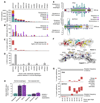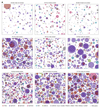Somatic mutant clones colonize the human esophagus with age
- PMID: 30337457
- PMCID: PMC6298579
- DOI: 10.1126/science.aau3879
Somatic mutant clones colonize the human esophagus with age
Abstract
The extent to which cells in normal tissues accumulate mutations throughout life is poorly understood. Some mutant cells expand into clones that can be detected by genome sequencing. We mapped mutant clones in normal esophageal epithelium from nine donors (age range, 20 to 75 years). Somatic mutations accumulated with age and were caused mainly by intrinsic mutational processes. We found strong positive selection of clones carrying mutations in 14 cancer genes, with tens to hundreds of clones per square centimeter. In middle-aged and elderly donors, clones with cancer-associated mutations covered much of the epithelium, with NOTCH1 and TP53 mutations affecting 12 to 80% and 2 to 37% of cells, respectively. Unexpectedly, the prevalence of NOTCH1 mutations in normal esophagus was several times higher than in esophageal cancers. These findings have implications for our understanding of cancer and aging.
Copyright © 2018 The Authors, some rights reserved; exclusive licensee American Association for the Advancement of Science. No claim to original U.S. Government Works.
Conflict of interest statement
Figures




Comment in
-
Colony takeover.Nat Rev Cancer. 2018 Dec;18(12):725. doi: 10.1038/s41568-018-0080-x. Nat Rev Cancer. 2018. PMID: 30420766 No abstract available.
-
The paradox of mutations and cancer.Science. 2018 Nov 23;362(6417):893-894. doi: 10.1126/science.aav5697. Science. 2018. PMID: 30467157 No abstract available.
-
Accumulating mutations.Nat Med. 2019 Jan;25(1):19. doi: 10.1038/s41591-018-0329-7. Nat Med. 2019. PMID: 30617327 No abstract available.
-
Mutations differ in normal and cancer cells of the oesophagus.Nature. 2019 Jan;565(7739):301-303. doi: 10.1038/d41586-018-07737-8. Nature. 2019. PMID: 30643303 No abstract available.
-
Mutation and clonal selection in the ageing oesophagus.Nat Rev Gastroenterol Hepatol. 2019 Mar;16(3):139. doi: 10.1038/s41575-019-0117-y. Nat Rev Gastroenterol Hepatol. 2019. PMID: 30705396 No abstract available.
-
Decoy fitness peaks, tumor suppression, and aging.Aging Cell. 2019 Jun;18(3):e12938. doi: 10.1111/acel.12938. Epub 2019 Mar 8. Aging Cell. 2019. PMID: 30848555 Free PMC article.
References
-
- Merlo LM, Pepper JW, Reid BJ, Maley CC. Cancer as an evolutionary and ecological process. Nature reviews. Cancer. 2006;6:924–935. - PubMed
Publication types
MeSH terms
Substances
Grants and funding
LinkOut - more resources
Full Text Sources
Other Literature Sources
Medical
Research Materials
Miscellaneous

